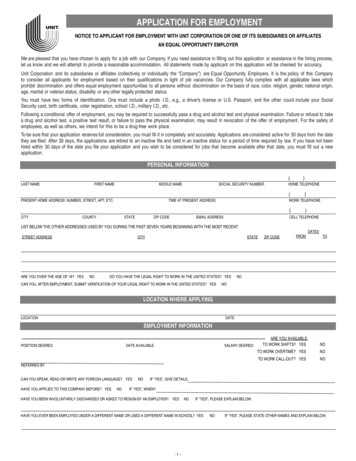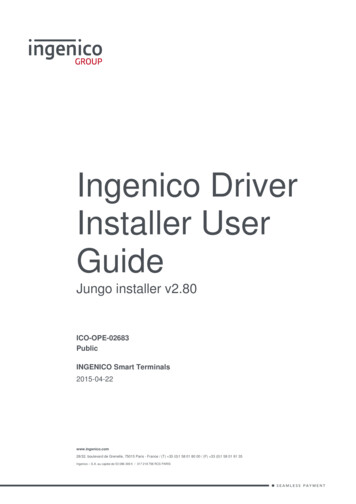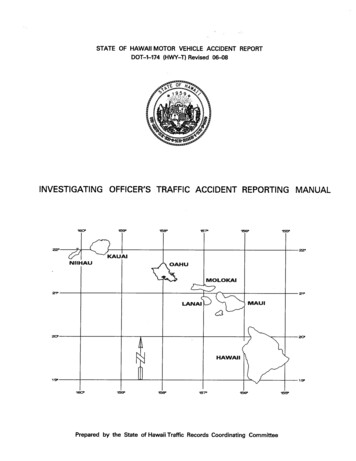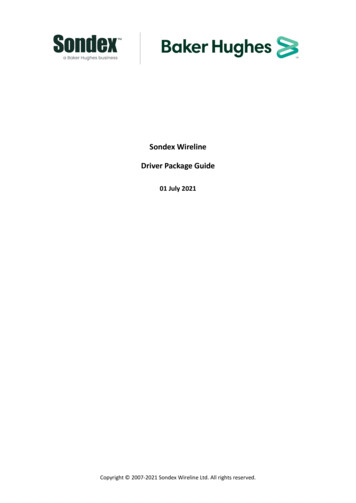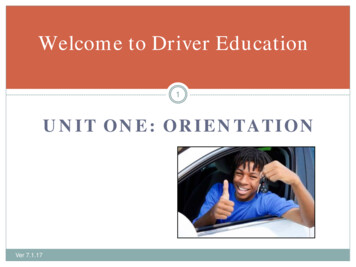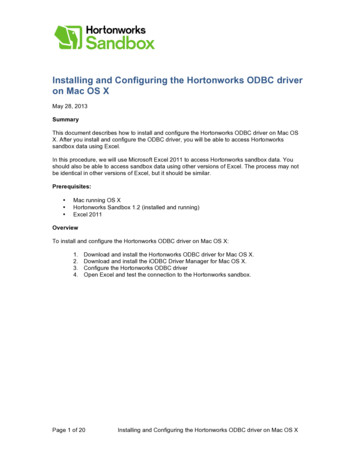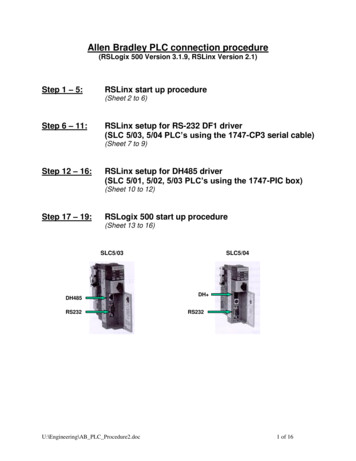
Transcription
In the film, humans, animals, and machinescome together in solidarityLeo CaraxDriver-less Vision:Learning to Seethe Way Cars DoFake Industries Architectural Agonism,Guillermo Fernandez-Abascal, andPerlin StudiosRecent developments in driverless technologieshave brought discussions around urbanenvironments to the forefront. While developingthe actual vehicles, major players such as Waymo(Google), Volkswagen, or Uber are equallyinvested in envisioning the future of cities.Yet, the proposed scenarios tend to emphasizeconsensual solutions in which idealized imagesof the streets seamlessly integrate driverlesstechnology. Avoiding the immediate future,these visions focus on a distant time in which thetechnology has been hegemonically deployed:Only driverless cars circulate while humans, cityinfrastructure, and autonomous vehicles havelearned to live together.11. Future scenarios tend to focus their predictions on how driverless cars combinedwith a sharing economy could reduce drastically the total amount of cars and onthe implications of this reduction in urban environments. Brandon Schoettle andMichael Sivak of the University of Michigan Transportation Research Instituteforesee a 43% contraction. (Brandon Schoettle and Michael Sivak, “PotentialImpact of Self-driving Vehicles on Household Vehicle Demand and Usage,” /uploads/2015/02/UMTRI-2015-3.pdf ([accessed February 2017]). Sebastian Thrun, a computer scientist at StanfordUniversity and former leader of Google’s driverless project predicts a 70% ; see “IfAutonomous Vehicles Rule the World,” The Economist, ss-driverless (accessed February 2017)). MatthewClaudel and Carlo Ratti anticipate an 80% reduction (Matthew Claudel andCarlo Ratti, “Full Speed Ahead: How the Driverless Car Could Transform Cities,”Mckinsey.com, -cities, accessed January 2017). Luis Martínez of the InternationalTransport Forum expects a 90% decline in his study of Lisbon mobility (LuisMartínez, “Urban Mobility System Upgrade: How Shared Self-driving Cars CouldChange City Traffic,” CITF, OECD, 5cpb self-drivingcars.pdf, accessed January 2017). In a similar exercise, DanFagnant of the University of Utah forecasts a 90% decline for the city of Austin(Daniel James Fagnant, “Future of Fully Automated Vehicles: Opportunities forVehicle- and Ride-sharing, with Cost and Emission Savings,” Ph.D. diss., Universityof Texas, ce 1 (accessed February 2017).All of these hypotheses operate in a distant future when the technology has beenfully implemented. IEEE predicts up to 75% of vehicles will be autonomous inMOVING298
This paper argues instead that the conflictsuntapped by the new technology’s disruptiveeffects will trigger the most meaningfultransformations of the city and that thesechanges they will happen in the near future. Thefast deployment of driverless technology doesnot preclude a specific urban solution. Rather,it requires our imagining how the cohabitationof humans and cars is going to be discussed.Our hypothesis entails that, in the shortterm, the urban realm will be the place wherethe negotiation will take place and that thedifferences in the ways cars and humans sensethe city will define the terms of the discussion.After successful deployment of autonomous vehiclesin close circuits and major non-urban areas, thecity has become the ultimate frontier for driverlesstechnologies. Personal rapid transit systems (PRT)operating in closed systems like the self-drivingpods in Heathrow Airport have been successfullyrunning since the end of yhe last century.2Adaptive Cruise Control, Automatic EmergencyBraking, or Automatic Parking are widelyavailable in commercial cars. Tesla, BMW,Infiniti, and Mercedes-Benz offer models withAutomatic Lane Keeping that guides the carthrough freeways and rural roads without relyingon the driver’s hands, eyes, or judgment.3 Yet thecity seems to resist the wave of autonomous cars.Several reasons explain why. Urban environmentsmultiply the chances of unforeseen events anddramatically increase the amount of sensorialinformation required to make driving decisions.The quality and amount of data is directlyproportional to the price of the technology andto the chances of the car’s successfully resolvingdifficult situations. It also is inversely proportionalto the car’s processing and decision-making speed.2040 and IHS forecasts that almost all of the vehicles in use will be driverlessby 2050; see IEEE, “Look Ma, No Hands!,” http://www.ieee.org/about/news/2012/5september 2 2012.html (accessed February 2017) and IHS,“Emerging Technologies: Autonomous Cars—Not If, But When,” http://www.ihssupplierinsight.com/ echautonomous-car-2013-sample 1404310053.pdf (accessed February 2017).2. Personal rapid transit (PRT) was developed in the 1950s as a more economicalresponse to the conventional metro system supported by the Urban MassTransportation Administration (UMTA). Originally they had similar capacity to carsbut as they evolved into bigger vehicles they lost these advantages. As a result onlyone PRT was built, in Morgantown, WV (USA). It has been operating successfullysince then. We can position Heathrow’s pods, the Sky Cube in Suncheon (Korea), orMasdar Abu Dabhi pods as their latest implementations of this technology.3. In January 2014, SAE International (Society of Automotive Engineers)issued a classification system defining six levels of automation, spanningfrom no automation to full automation (0 to 5), with the goal of simplifyingcommunication and collaboration among the different agents involved. Theclassification is based on the amount of driver intervention and attention requiredinstead of the vehicular technological devices. The characterization sets a crucialdistinction between level 2, where the human driver operates part of the dynamicdriving task, and level 3, where the automated driving system carries out alldynamic driving task. SAE., “Automated Driving. : Levels of Automation AreDefined in New SAE International Standard J3016”,” https://www.sae.org/misc/pdfs/automated driving.pdf (accessed February 2017)). Later in 2014, Navyalaunched a self-driving vehicle (level 5) which has been performing successfullyin different closed environments from Switzerland to France, the United States,Driver-less Vision: Learning to See the Way Cars Do Fake Industries Architectural Agonism et al.299
The equilibrium between these two opposedparameters defines different approaches to thedriverless cars.4 Eventually, it will also define howthe streetscape needs to change to accommodatethe cohabitation of autonomous vehicles,regular cars, pedestrians, and other forms oftransportation.The presence of self-driving cars in urbanenvironments also challenges accepted notionsof safety. Accidents involving self-driving cars arewell documented. Google issued a public reportmonthly until November 2016. Tesla and Uberare more secretive, but their accidents tend tobecome media events.5England, and Singapore. Arma, their latest carrier, is operating trials under fixed routesin urban scenarios. The shuttle can transport up to 15 passengers and drive up to 45km/h. Other major players have been testing vehicles in closed environments andon public roads under special circumstances. When driven on public roads, the carsrequire at least one person to monitor the action and assume control if needed. Someof the more popular testing programmes involve companies such as Waymo (Google),Tesla, or Uber. Google has been testing their cars since 2009 on freeways and testinggrounds. In 2012, they shifted to the city streets, identifying the need to do tests inmore complex environments. In their latest published monthly report, in November2016, their vehicles operated 65% of the time on autonomous mode. Along thelifespan of the programme they have accumulated more than 2 million self-drivenmiles.(Waymo, “Journey,” https://waymo.com/journey/ [accessed February 2017]).Tesla started deploying their Autopilot system in 2014, with a level 2 automatedvehicle. In October 2016, Tesla announced that their vehicles have all the necessaryhardware to be fully autonomous ( level 5 capabilities). However, as they clearly state,its functionality depends on extensive software validation and regulatory approval.They currently offered multiple capacities such as adaptive cruise control or autosteer.Initially, the systems could only be deployed on specific highways but at as ofFebruary 2017, they also perform in some urban situations. (Tesla, “Full Self-DrivingCapability,” https://www.tesla.com/autopilot [accessed February 2017]).Uber joinedthe race in 2016. Their controversial programme offered, right after nuTonomy’s pilotscheme, to carry fare-paying passengers in cars that have a high level of autonomy.The vehicles deploying this service have two employees in the front seats to monitorand take control in case of problems.4. Tesla’s current sensing system arrays eight cameras that provide 360 degrees ofvisibility with a range of 250 m. Twelve ultrasonic sensors and a forward-facing radarcomplement and strengthen the system. However, Waymo and most of the othercompetitors follow a different approach. (Tesla, “Advanced Sensor Coverage,” https://www.tesla.com/autopilot [accessed February 2017]).Waymo’s most advanced vehicle,a Chrysler Pacifica Hybrid minivan customised with different self-driving sensors,relies primarily on LiDAR technology. It has three LiDAR sensors, eight visionmodules comprising multiples sensors and a complex radar system to complement it.(Waymo team, “Introducing Waymo’s Suite of Custom-built, Self-driving Hardware,”Medium, of-custom-builtself-driving-hardware-c47d1714563 [accessed February 2017]).5. Tesla’s fatal accident occurred on 7 May 2016 in Willston, Florida, while a TeslaModel Selectric car was engaged in Autopilot mode; see Anjali Singhvi and KarlRussell, “Inside the Self-Driving Tesla Fatal Accident,” New York Times, 1 July 1/business/inside-tesla-accident.htmlMOVING300
The majority of these events involve single vehicles or collisions between two or more vehicles.Urban environments increase the chances ofaccidents involving pedestrians and other formsof non-vehicular traffic. The ethical implicationsof this scenario have been popularized by MIT’sinteractive online test, Moral Machine.6Self-driving technologies imply a transfer ofaccountability to the algorithms that guide thevehicle. Most legal experts predict a trend towardsincreased manufacturer liability with increaseduse of automation. Major players such as Volvo,Google, or Mercedes already supported thissolution in 2015. Car manufacturers will acceptinsurance liabilities after full automatization(level 5) is a reality.7 But safety goes beyond theinsurance conundrum. In Aramis, or the Love ofTechnology, Bruno Latour proves how the successof a new technology is deeply connected with theperceived dangers it entails.8To share the streets with cars driven by computers shakes collective notions of acceptable risk.The technology needs to prove trustworthy. Andtrust, in this cases, results from a combinationof scientific evidence, storytelling, and publicdemonstrations constructed by the engineers,economies, and populations involved in their development. When common agreements regarding trust and responsibility shift, the way we willlive together needs to be settled, again.9(accessed February 2017). Uber’s most recent accident happened on 24 March2017. Although they were not accused for being responsible of the accident, theytemporarily suspended their programmes in their three testing locations: Arizona,San Francisco, and Pittsburgh. See Mike Isaac, “Uber Suspends Tests of SelfDriving Vehicles After Arizona Crash,” New York Times, 25 March 2017, a-crash.html.6. Iyad Rahwan, Jean-Francois Bonnefon, and Azim Shariff, “Moral Machine:Human Perspectives on Machine Ethics,” http://moralmachine.mit.edu/ (accessedJanuary 2017).7. Kirsten Korosec, “Volvo CEO: We Will Accept All Liability When Our Cars Arein Autonomous Mode,” Fortune, 7 October 2015, -driving-cars/ (accessed February 2017), and Bill Whitaker,“Hands off the Wheel,” Sixty Minutes, CBS, e-mercedes-benz-60-minutes/ (accessed February 2017).8. Bruno Latour, Aramis, or the Love of Technology (Cambridge, MA: HarvardUniversity Press, 1996).9. Charles Perrow analyzes the social side of technological risk. He argues that accidentsare normal events in complex systems; they are the predetermined consequences ofthe way we launch industrial ventures. He believes that the conventional engineeringapproach to ensuring safety, building in more warnings and safeguards, is inadequatebecause complex systems assure failure. Charles Perrow, Normal Accidents: Living withHigh-Risk Technologies. (Princeton, NJ: Princeton University Press, 1999). Hod Lipson,professor at Columbia University and co-author of Driverless, Intelligent Cars and theRoad Ahead, advises that the Department of Transportation should define a safety standard based on statistical goals, not specific technologies. They should specify how safea car needs to be before it can drive itself, and then step out of the way.(Cited in RussMitchell, “Why the Driverless Car Industry Is Happy (So Far) with Trump’s Pick forTransportation Secretary,” Los Angeles Times, 5 December 2016, o-trump-driverless-20161205-story.html.Driver-less Vision: Learning to See the Way Cars Do Fake Industries Architectural Agonism et al.301
If dense urban environments intensify theconflicts between technology, ethics, economy,and collective safety, the realm of sensing rendersthe conflicts public. The arrival of autonomousvehicles entails the emergence of a new type ofgaze that requires the negotiation of existing codes.Currently, human perception defines the visualand sonic stimuli that regulates urban traffic. Thetransfer of information has been designed, withfew exceptions, to be effective for human visionand in some cases for human audition. Driverlesssensors struggle with these logics; e.g., redundancy,used to capture drivers’ attention, often producesa confusing cacophony for autonomous vehicles.Dirtiness on the road graphics, misallocationsof signage, consecutive but contradictory trafficsigns, or even the lack of proper standardization oftraffic signs and markings are the reasons behindsome of the most notorious incidents involvingautonomous vehicles.10Assuming that driverless cars will adapt to theseconditions implies a double contradiction.It forgets the history of transformations ofstreetscape associated with the changes in vehiculartechnologies.11 But more importantly, it ignores10. Several relevant figures in the field such as Elon Musk from Tesla, Lex Kerssemakers,the North America Volvo CEO, and Christoph Mertz, a research scientist at CarnegieMellon University, have pointed out the problem of faded lanes in the currentdevelopment of the technology. Paul Carlson, from Texas A&M University, aims forconsistency in signage along American roads in order to accommodate automationfavorably. The agency Reuters also points out that the lack of standardization in theUS compared to most European countries, which follow the Vienna Convention onRoad Signs and Signals, causes a big problem. At the same time several researchers atSookmyung Women’s University and Yonsei University in Seoul are focusing on howcurrent automated sign recognition systems detect irrelevant signs placed along roads.This problematic cacophony is dramatically amplified in urban scenarios. See AlexandriaSage, “Where’s the Lane? Self-driving Cars Confused by Shabby U.S. Roadways,”Reuters, -infrastructure-insigidUSKCN0WX131 (accessed December 2016); Andrew Ng and Yuanquin Lin.“Self-Driving Cars Won’t Work Until We Change Our Roads—And Attitudes,” rs-wont-work-change-roads-attitudes/(accesed December 2016); and Signe Brewster, “Researchers Teach Self-driving Cars to‘See’ Better at Night,” Science, teach-self-driving-cars-see-better-night (accessed March 2017).11. The relationship between the transformations of the streetscape and the arrivalof new vehicular technologies also places driverless cars at the center of the history ofarchitecture. Since its inception, the car has often played a central role in architects’urban visions. The precepts of the Athens Charter and the images of the Ville Radieusewere an explicit responses to the safety and functional issues associated with thepopularization of car. Its implementation, with different degrees of success, during thepost-war reconstruction of Europe and the global explosion of suburban sprawl, fueledarchitectural controversies that questioned the role of cars in the definition of urbanenvironments. Ian Nairn’s Outrage (1955), Robin Boyd’s Australian Ugliness (1960),Appleyard, Randolph Myer, and Lynch’s The View from the Road (1964), Peter Blake’sGod’s Own Junkyard (1965), Reyner Banham’s Los Angeles: The Architecture of FourEcologies (1971), Venturi, Scott-Brown and Izenour’s Learning from Las Vegas (1973),and Alison and Peter Smithson’s AS IN DS: An Eye on the Road (1983) are not onlysome well-known examples of these debates; they also show how the topic lost tractionin architecture debates at the end of the last century.MOVING302
the fact that self-driving cars construct images thatare barely comparable to human perception.12Driverless cars take in real-time data throughdifferent on-board sensors. Although there isnot an industry standard yet, certain trends areubiquitous. The vehicles use a combination ofradars, cameras, ultrasonic sensors, and LiDARscanners to get immediate information from theexternal environment.13 The resulting perceptiondiffers greatly from a human one. Driverless carsdo not capture environmental sound. Colourrarely plays a role in the way they map the city.And, with various degrees of resolution, theirsensors cover 360 degrees around the vehicle.At the same time, car sensors and human sensesshare a logic of specialization. The human senseof hearing tends to recognize exceptional andabrupt changes in the sonic landscape—a siren,a claxon, a change in the sound of the engine.Even if human peripheral vision operates in asimilar fashion, attention is essential for eyesight.Human vision requires continuity and focusseson subtle changes. Thus fog or darkness decreasethe eye’s ability to discern difference and decreaseits effectivity. Similarly, the way self-drivingcars’ sensors function defines their potentialsand limitations. Some sensors detect the relativespeed of objects in close range while otherscapture the reflectivity of static objects far away.Some are able to construct detailed 3D modelsof objects no farther than a meter away whileothers are indispensable for pattern recognition.Human drivers combine eyesight and hearing tomake decisions and driverless cars’ algorithms useinformation from multiple sensors in theirdecision-making processes. Yet, autonomousvehicles’ capacity for storing the informationtheir sensors capture makes a big difference. Aseach of the four types of sensors in a driverless carcaptures the area they circulate, they also producea medium-specific map of their environment.Radars are object-detection systems that use radiowaves to determine the range, angle, or velocity ofobjects. They have good range but low resolution,especially when compared to ultrasonic sensors andLiDAR scanners. They are good at near-proximitydetection but less effective than sonar. They workequally well in light and dark conditions andperform through fog, rain, and snow. While theyare very effective at determining relative speedof traffic, they do not differentiate colour orcontrast, rendering them useless for optical patternrecognition. They are critical to monitoring thespeed of other vehicles and objects surrounding theself-driving car. They detect movement in the cityand are able to construct relational maps capturingsections of the electromagnetic spectrum.Ultrasonic sensors are object-detection systemsthat emit ultrasonic sound waves and detecttheir return to define distance. They offer a verypoor range, but they are extraordinarily effectivein very-near-range three-dimensional mapping.Compared to radio waves, sound waves are slow.Thus, differences of less than a centimetre aredetectable. They work regardless of light levelsand also perform well in conditions of snow, fog,and rain. They do not provide any12. Uber’s arrival is linked to the famous Google lawsuit against Uber that positionLiDAR technology at the centre of the dispute. Again, this legal battle locates thediscussion of the car’s ability to see the world. See Alex Davies, “Google’s Lawsuit AgainstUber Revolves Around Frickin’ Lasers,” Wired, revolves-around-frickin-lasers/ (accessed March 2017).13. For a detailed list of the the onboard sensors used by different self-driving carbrands, see footnote 4.Driver-less Vision: Learning to See the Way Cars Do Fake Industries Architectural Agonism et al.303
Up to the left:360 immersive projection in the dolbydome for Vivid 2016 FestivalUp to the right:Black Shoals Dome exhibited atNikolaj Copenhagen ContemporaryArt CentreOn the left:Still from “Where the City can See”a LiDAR film by Liam Young305
colour or contrast or allow optical characterrecognition, but they are extremely usefulto determine speed. They are essential to forautomatic parking and to avoid low-speedcollisions. They construct detailed 3D maps ofthe temporary arrangement of objects in theproximity of the car.LiDARs (Light Detection and Ranging)are surveying technologies that measuredistance by illuminating a target with a laserlight. They are currently the most extendedobject-detection technology for autonomousvehicles. They generate extremely accuraterepresentations of the car’s surroundings butfail to perform in short distances. They cannotdetect colour or contrast, cannot provide opticalcharacter recognition capabilities, nor they areeffective for real-time speed monitoring. Lightconditions do not decrease their functionality,but snow, fog, rain, and dust particles in theair do. Due to their use of light spectrumwavelengths, LiDAR scanners can sense smallelements floating in the atmosphere. Theyproduce maps of quality of air quality.RGB and infrared cameras are devices thatrecord visual images. They have very highresolution and operate better in long distancesthan in close proximity. They can determinespeed, but not at the level of accuracy of radar.They can discern colour and contrast butunderperform in very bright conditions and alsoas light levels fade. Cameras are key for the car’soptical-character recognition software and are defacto surveillance systems.This proliferation of sensors in the environmentis a defining factor of the imminent urban milieu.Environmental sensors connected to cars distribute instant remote sensing, enabling the constantflow of information on the urban environmentwhile at the same time radicalizing issues ofprivacy, access, and control. They simultaneouslyreact to and change the urban pattern, generatingan unprecedented environmental consciousness.The resulting image of the city cannot differ morefrom human perception. It is a combination ofsections of the electromagnetic spectrum, detailed3D models around cars, detailed maps of air pollution, and an interconnected surveillance system.It is not the city as we see it.And yet interconnected sensors can create a newcommon, a ubiquitous, global sensorium that obliterates further the distinction between nature andartifice. While the city is managed by non-humanagencies, it continues to be designed around theassumption of a benign human-centered system.Engaging citizens in this new sensorial environment makes them aware of the necessity of a newsensorial social contract.14 It embeds the judgmentof society, as a whole, in the sensorial governanceof societal outcomes. The city is therefore the spacewhere we can gain mutual confidence trust, generating the necessary relationship for coming scenarios of coexistence. In other words, driverless visionisn’t just about cars, rather it is more akin to theinteraction between a government and a governedcitizenry. Modern government is the outcome of animplicit agreement—or social contract—betweenthe ruled and their rulers, aimed at fulfilling thegeneral will of citizens.14. “Algorithmic Social Contract” is a termed coined by MIT professor Iyad Rahwanand develops the idea that by understanding the priorities and values of the public,we could train machines to behave in ways that the society would consider ethical.See Iyad Rahwan, “Society-in-the-Loop: Programming the Algorithmic SocialContract,” www.medium.com p-54ffd71cd802 (accessed March 2017).MOVING306
driverless cars.4 Eventually, it will also define how the streetscape needs to change to accommodate the cohabitation of autonomous vehicles, regular cars, pedestrians, and other forms of . Intelligent Cars and the Road Ahead, advises that the Department of Transportation should define a safety stan-
